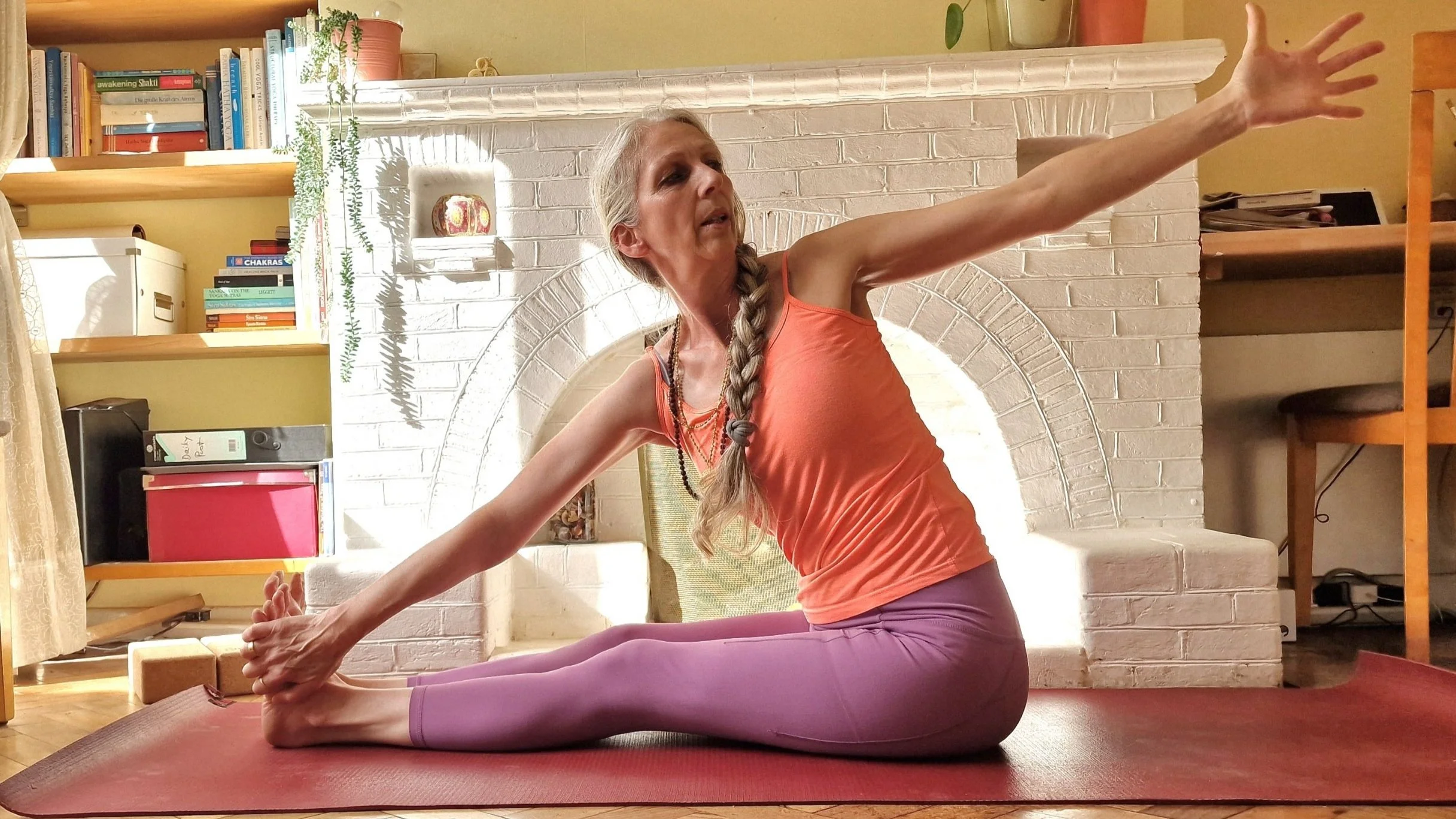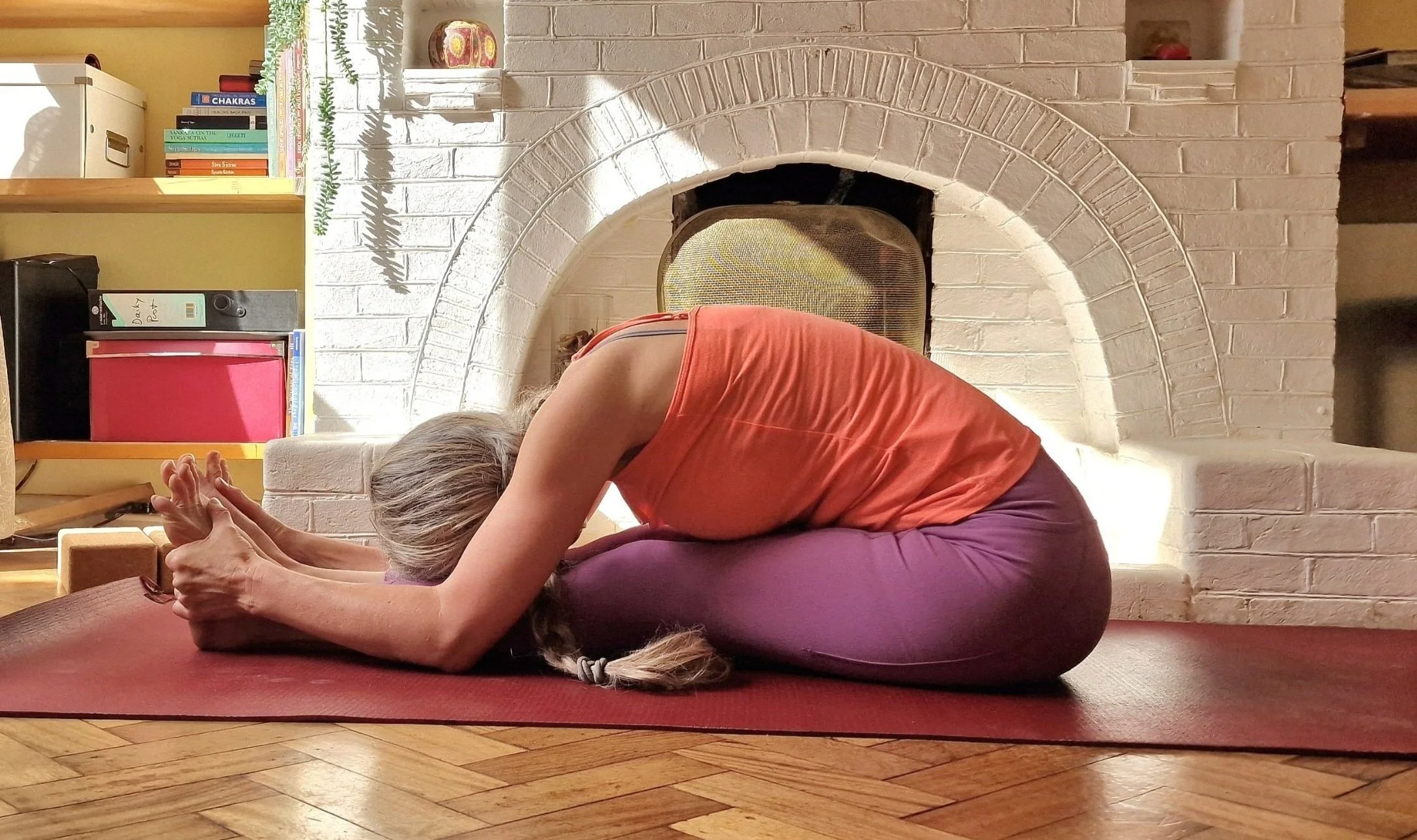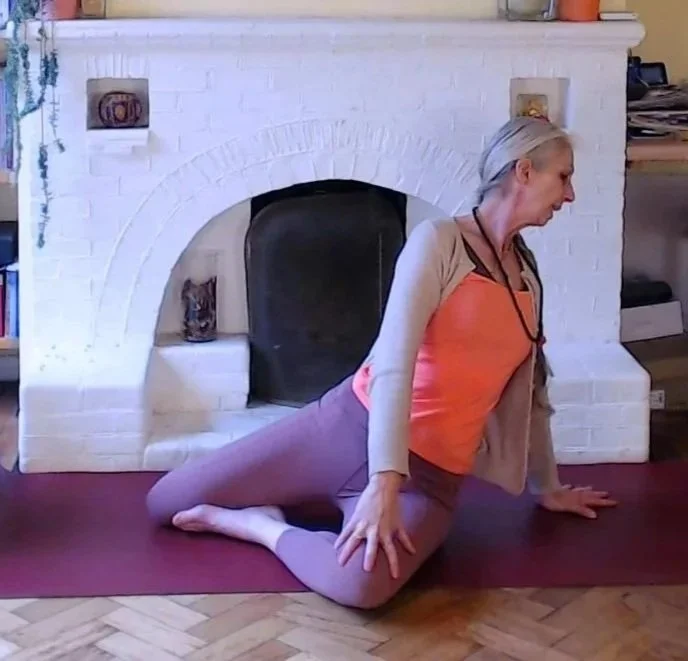Adapting Your Yoga to Autumn (Vata Season)
Soften the season’s restless energy with steady, grounding practice.
Prefer to listen?
You can press play below to hear this episode of Rooted in the Seasons, or scroll down to read it as a blog post.
TL;DR — What changes in autumn (and how your yoga should)
Autumn amplifies the qualities of mobile, light, cool, dry, and erratic (Vata). Your yoga benefits from the opposites: stillness, weight, warmth, oiliness, and rhythm.
Quick tweaks for your mat:
Look down for balance. Fix your drishti on a still point on the mat to counter the season’s “up-and-out” energy.
Stand and root. Choose strong, symmetrical standing poses and feel heaviness through the feet — press down to settle.
Slow the flow. Fewer transitions, 5–8 steady breaths per pose; smooth, unforced Ujjayi or gentle nasal breathing.
Warmth + oil. Keep the room comfortably warm; a light oil massage before practice calms and steadies Vata.
Finish long. Add extra Savasana and short seated breathing (Alternate Nostril Breath) to seal in calm.
You don’t need a perfect setup — even ten quiet minutes can shift how you feel.
Start small, stay consistent, and notice the difference in your mind and mood.
Why Adapt Yoga in Autumn?
The sound of rustling leaves underfoot reminds us of movement and change. Yet the same wind and dryness we love to walk through can show up in our own bodies and minds — as restlessness, tension, or fatigue.
If you’ve felt a little restless or dry, it’s not just you. Autumn’s airy, mobile quality scatters attention, tightens the breath, and can leave joints and skin parched. In my cornerstone post, “Autumn with Ease: Ayurveda and Yoga for Balance and Calm”, I talk about why this happens — how the air and space elements rise during Vata season, and why they can leave us feeling scattered, chilly, or depleted.
Yoga works best when it meets the moment — we adapt tempo, focus, and shape so our practice becomes medicine: grounding for the mind, warming for the body, and rhythmic for the nervous system.
The aim: shift from upward, windy, fast → to downward, steady, warm.
Want to feel steadier beyond your yoga practice this autumn?
You’ll love this free guide I put together to help you stay centred and grounded through the season.
Download “My 5 Quick Ayurvedic Fixes from Scattered to Steady” — a free guide to help you feel grounded, centred, and steady so your nervous system can relax as deeply as your yoga practice.
✨ You’ll also receive my Sunday Read newsletter and new episodes from the Rooted in the Seasons blog/podcast..
Autumn Practice Principles
These are a few main principles to keep in mind during your yoga practice. You can also easily integrate them when attending your regular yoga class.
Drishti down, mind down. In balances, fix your gaze low — it steadies sway and quiets mental chatter.
Heaviness through contact points. Press the floor away with your feet. Feel weight through shins and thighs — that’s grounding in action.
Even, quiet breath. Think simmer, not boil. Gentle Ujjayi if it stays smooth; otherwise, slow nasal breath.
Rhythm over reps. Repeat simple sequences; rhythm calms the nervous system more than variety.
Contain warmth. Start layered, keep drafts out, and cover your eyes at the end to soothe Vata.
Here’s how to bring those principles to life on the mat.
Your Autumn Sequence Blueprint
A balanced sequence for 20–45 minutes. Pick one from each section.
1) Arrive & Warm (3–6 mins)
Seated or kneeling centring. Walk with your inner attention through joints and muscles and notice how they feel — use words to describe those sensations for yourself. This brings more awareness and clarity; it also helps identify potential areas to be mindful of during your practice. Place hands on belly and chest; breathe smoothly 8–10 times.
Cat–Cow x 6–8 rounds (slow, following breath).
Child’s Pose (wide knees), 5–8 breaths, forehead resting.
2) Grounded Sun (3–5 mins)
Begin with Sun Breath, then gentle Half Sun Salutes (no Chaturanga), 3–4 rounds. Move one breath per move.
Option: Low Lunge → Downward Dog mini-flow, 3 breaths each, twice per side.
3) Standing & Rooting (8–12 mins)
Triangle → Warrior I or II → Side Angle. 5–6 breaths per pose, focus on pressing down through the feet and softening the ribs.
Chair Pose (hands at heart), 3–5 breaths, feel weight in heels.
Optional: Goddess or Wide-Leg Forward Fold with hands on blocks.
4) Balance with a Downward Gaze (3–5 mins)
Tree Pose. Gaze softly at the front edge of your mat. Cue: “See the breath move, not the room.” Hold 5–8 breaths each side.
If balancing feels challenging, skip advanced options. Stay near a wall, or focus on rooting evenly through both feet.
5) Forward Folds & Gentle Twists (5–8 mins)
Seated Forward Bend (Paschimottanasana) or Head-to-Knee Pose (Janu Shirshasana). 6–8 steady breaths, folding from the hips, knees soft.
Mermaid Twist or gentle Seated Twist, to lengthen spine before backbends.
6) Back Body & Front-Body Ease (5–8 mins)
Locust Pose (low lift) x 2 slow rounds, or Cobra Pose to open chest and breath.
Bridge with block under sacrum for support.
Supine Twist, 8–10 breaths each side.
7) Invert & Settle (4–6 mins)
Legs Up the Wall or calves on a chair, 2–4 minutes.
Supine Belly Breathing: knees bent, hands on belly, slow deep breaths for 1–2 minutes.
Optional: Easy Seated Twist before Nadi Shodhana.
8) Close (4–8 mins)
Nadi Shodhana (Alternate Nostril Breath), 3–6 rounds.
Savasana, 5–7 minutes, eyes covered, scarf over ears if it’s windy or cool.
Time-boxed versions:
20 min — Sections 1–4 + 8.
30 min — Sections 1–5 + 8.
45 min — Full sequence.
Helpful Cues
These short cues or sentences can help you focus on different areas more easily and might stay in your mind as gentle reminders when you start to sway off or move back into your usual patterns — especially those linked to the mobile, airy Vata qualities.
“Press down to settle.” (Feel energy move downward.)
“Gaze still; breath smooth.”
“Breathe into your back body.”
“Quieter, not bigger.” (Autumn isn’t the season to push range.)
“Finish warmer than you started.”
Props for Autumn Support
Props can sometimes feel tricky to use — especially if you’re new to them and not sure what to do. Firstly, remember they’re here to help you bridge gaps, feel more supported, and deepen awareness, not to confuse you. Props are always optional. The following are a few easy-to-use tools you could try. Straps can be substituted with a long belt or towel, and books or a stack of weighty blankets can make a nice alternative to blocks.
Blocks — add weight and stability in folds and balances.
Strap — supports reach while keeping shoulders and the nervous system relaxed.
Eye pillow or scarf — softens senses, signals rest.
Optional: a few drops of nasya oil or a short self-massage (abhyanga) before yoga. Yoga lubricates the joints through mindful movement — oils simply enhance that effect while calming the mind.
Why the “Look Down” Cue Works
Vata season pulls our attention up and out. When we look high or around, the vestibular system overworks and balance feels harder. A low, still gaze reduces visual noise and instantly settles the body-mind. Try Tree Pose twice — once glancing around, once with eyes fixed softly on the mat — you’ll feel the difference.
Mermaid Twist
FAQs
Is Ujjayi okay in autumn? Yes. Its steady, wave-like rhythm and ocean-like sound build inner warmth and quiet strength — a gentle victory over distraction, restlessness, and self-doubt.
Should I skip vinyasa entirely? No. Keep it simple and slow, breath-led, not performance-led.
How long should I hold poses? 5–8 breaths is ideal—long enough to feel steady, not strained.
How do I know I’ve done enough? You end warmer, heavier, calmer — and not in a hurry to get up.
5-Pose “Any Day” Mini Sequence
Here is a sort of a default mini sequence, when it needs to be super-fast. Each suggestion can be done on its own or combined with Legs Up the Wall for a quick reset. Apart from Warrior II, which should be combined with the Shoulder + Hip Mobilisers to prepare those areas.
Shoulder + Hip Mobilisers (see my Joint Health YouTube Playlist)
Cat–Cow x 6
Low Lunge → Half Splits (2 rounds/side)
Warrior II (6 breaths/side)
Legs Up the Wall → Savasana (5 minutes total)
Final Thoughts
Autumn calls for steadiness and softness. Keep shapes simple, the breath silky, and the gaze quiet. Over time, these small shifts steady your energy and bring a deeper sense of rooted calm.
I explore this idea of living in sync with the seasons — and how rhythm supports your energy, mood, and digestion — more deeply in my Lift Your Mood with Food course.
Take a moment to reflect:
What felt most grounding for you today?
Which cue will you carry with you off the mat and into your week?
This practice is the “how.” For the deeper “why” — how the qualities of air and space shape our energy and mood — have a read of Autumn with Ease: Ayurveda and Yoga for Balance and Calm.
Support your practice: If you’d like to take your autumn routine a little deeper, try adding a warm abhyanga (self-massage) before yoga. It prepares joints and muscles, brings strength, reduces excess Vata, and invites stillness.
If you’re exploring oils, my autumn/winter favourite is Dr Deepa’s De-Stress Vata Formula. The link gives you a 10% discount. Or use what feels good — the goal is warmth and nourishment, not perfection.
Written for busy, health-conscious women who want to feel calm without overhauling everything. Bookmark this for windy days and return whenever you need grounding.
Resources
💡 Want to explore more Ayurvedic tips, recipes, and practices for autumn? Here are some extra resources you might enjoy:
Ayurveda for Autumn: Balance Vata and Ease Stress
Restorative Yoga Mini Series | 3 Poses for Deep Rest
6 Ayurveda Tips to Stay Centred in the Autumn Shift


